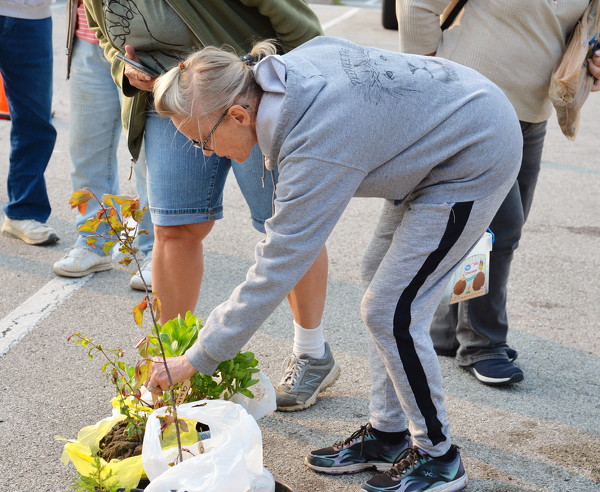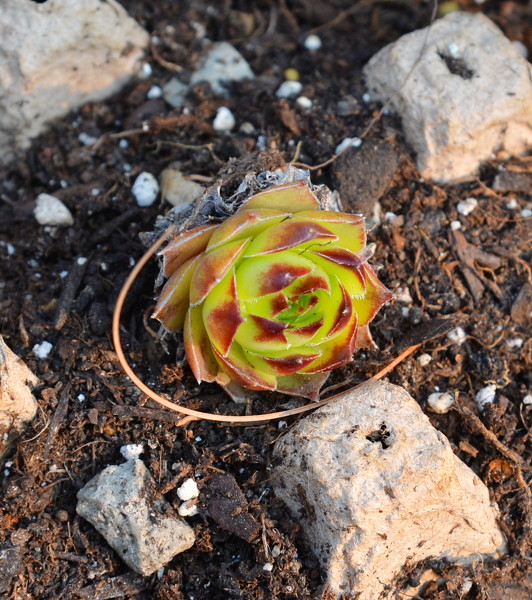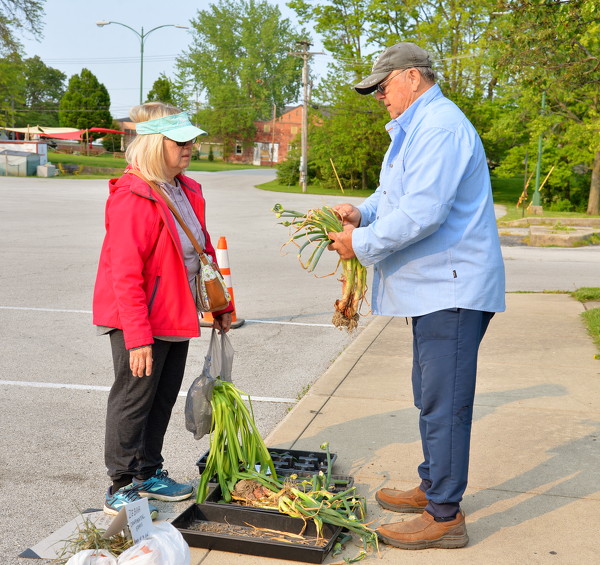
Anna McMurray inspects a plant at the garden swap at St. Marys Community Public Library on Thursday.
ST. MARYS - Green thumbs came together earlier this week to share gardening advice and swap and trade their extra plant cuttings, seeds and containers.
The Heritage Trails Park District and the St. Marys Community Public Library hosted the annual gardener's swap and share event on Wednesday at the library.
About 30 people attended the event, which included a presentation by Lori Osterloh-Hagaman, or Lori the Herbchick, about edible and medicinal plants.
The event is an opportunity for the community to get together and share excess plants and divisions, plant seedlings, gardening tools, containers and extra seeds with their neighbors and friends, said Terry McDonald, administrative assistant for Heritage Trails Park District.
A gardener's paradise of Egyptian walking onions, tomato starts, black-eyed Susans, prickly pear cactus pads, succulents, aloe plants, hosta starts and empty nursery pots lined the library's sidewalk, free for the taking.

Tiny succulents wait to be taken home at the garden swap at St. Marys Community Public Library on Thursday.
"(It's a good way to) get a jump start on their gardening without spending any money," McDonald said. "May is a great time to get started on that. I think that it's a good time to get off our electronics and (get) outdoors in the soil. Whether you have a green thumb or a brown thumb, this is a great time to explore and maybe try a new plant you're not familiar with."
For example, prickly pear cactus is an Ohio-native outdoor cactus, said Allison Brady, Heritage Parks executive director. The cactus can be left in the ground all year and produces a beautiful yellow/orange flower, which turns into the prickly pear fruit.
Neal Brady of Wapakoneta brought the prickly pear pads by the boxful. He said he got the plant from a friend 40 years ago and has raised them since.

Paul Warner, Elida, shows off his Egyptian walking onions during the garden swap at St. Marys Community Public Library on Thursday.
Paul Warner of Elida brought several Egyptian walking onion starts. The plant, also known as a tree onion, is a perennial planted in the fall that produces reddish-purple bulblets on top of the stems in the spring, according to the Old Farmer's Almanac.
If not picked, the weight of the bulbs will bend the stem to the ground, where they will root and send up new plants, thus beginning their "walk" across the garden. These plants also produce bulbs in the soil, which multiply if not divided.
Warner said he uses the unusual onion like a green onion. He added the thick, white portion of the plant closer to the root is similar to shallots and can be finely minced.
In addition to onions, Warner said he specializes in growing tomatoes. He attributed good old-fashioned manure as the secret to a plump tomato.
After the trade, Osterloh-Hagaman talked about foraging for native and medicinal plants right in a gardener's backyard.
"As grocery costs have skyrocketed the last couple of years, foraging for native plants, as well as whatever happens to be coming up in your neighborhood, has become extremely popular," she said.
Some of the plants she discussed included purple dead nettles, dandelions and Queen Anne's lace. The majority of the plants she highlighted are edible and many have healing and nutritional benefits.
Purple dead head nettles, a mint relative, is 100% edible, high in iron and can be used topically as a soothing agent, Osterloh-Hagaman said.
A creeping Charlie plant, also edible, has "been noted in some herbals to be used as a lymphatic drainage remedy," she said. Other plants, such as the dandelion, have lesser-known benefits, such as using the leaves as a spinach replacement.
"We use the spring greens usually before it (the temperature) hits about 70-75," Osterloh-Hagaman said. "That's my own personal preference. The leaves are very, very tender first thing in the spring and I use them interchangeably with spinach. The nice part is some people cannot eat spinach because of its high oxalic acid content. Dandelion doesn't have that."
She said her grandpa, who lived through the Great Depression, would fry dandelion greens. She added foragers can batter and fry dandelion heads, which she said taste like fried mushrooms.
People can also gather dandelion root in the fall and eat them just like a carrot, she said. Some caffeine fiends even roast and grind the roots to use as an additive to their coffee. The heads can also be used to make dandelion wine or home-brewed beer, she said.
Another native plant, lamb's quarter, is high in vitamins A, C and E, high in iron and can be used like spinach, she said. Wild violet leaves can be used to soothe skin irritations and the sweet flowers can be used in jellies.
Queen Anne's lace are wild carrots that can get help get rid of vermin, she continued. Purslane, which looks like a jade plant, is edible and full of omega fatty acids.
As with all things, Osterloh-Hagaman said it's crucial to know what plants are and are not dangerous. For example, Queen Anne's lace can have similar visual characteristics to poison hemlock, which is extremely poisonous to humans, according to the U.S. Department of Agriculture.
Purslane has a superficial lookalike called spurge, she said. An easy way to tell the difference is by snapping a stem. Spurge, when torn, will produce a milky white sap that can irritate the skin and cause vomiting and diarrhea, she said.
Additionally, Osterloh-Hagaman advised against foraging or gathering near areas that have been treated with chemical pesticides or synthetically derived fertilizer.

